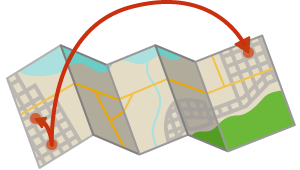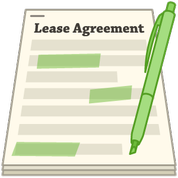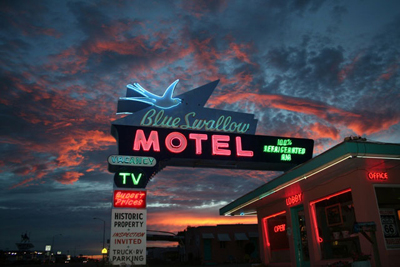 Lots of things about moving are kind of a drag. Financial strains, logistical concerns and the plain old act of uprooting oneself to a new home are all stressful enough on their own, but add to that the element of long-distance and you’ve got the makings of an ulcer on your hands. Right? Wrong. While Moveline works to decompress the frustrations typically associated with moving by saving people money, time and confusion, we also have a few tricks up our sleeves when it comes to turning a cross-country move more fun.
Lots of things about moving are kind of a drag. Financial strains, logistical concerns and the plain old act of uprooting oneself to a new home are all stressful enough on their own, but add to that the element of long-distance and you’ve got the makings of an ulcer on your hands. Right? Wrong. While Moveline works to decompress the frustrations typically associated with moving by saving people money, time and confusion, we also have a few tricks up our sleeves when it comes to turning a cross-country move more fun.
To kick things off, we’ve got some tips for folks moving between the Midwest and the West Coast (via Route 66), but first things first: no matter where you’re moving to or from, here’s a heaping helping of tips to turn that frown upside down as you get ready to relocate.
Get familiar with your new city
Sure, anybody can Google “fun things to do in City X,” but for a truly unflinching look at the way locals view their own neighborhoods, Urbane offers city maps with an irreverent take on various parts of most large US cities. Wondering where to find “Dominican artsy hipster living” in Miami or “clean-cut homes and streets that seem Middle America” in New Orleans? Look no further. Most chambers of commerce provide plenty of socioeconomic information on the communities they represent, along with links to city guides and helpful information, and when you’ve exhausted things like local newspapers and alt weeklies, there’s always Lonely Planet, Frommer’s and Fodors — because listen, if your new city’s best restaurants and diversions have already been reviewed and categorized by the world’s most esteemed travel writers, why not take advantage of their research? And while you’re at it, you can map out some fun, touristy stops and side trips to enjoy on the way there.
Specifically, if you’re moving to Seattle or Las Vegas and looking for a super-comprehensive insider’s guide with tips on where to live, work, eat, shop and play, check out Moveline’s new resident guides specifically written for folks moving to either city (with more cities to come soon).
Make the road trip fun
If you’re driving your own car to your new city instead of having it shipped, the long haul doesn’t have to be a boring one, especially when it comes to food. No matter where you’re going, a handful of websites and apps can help you avoid the fast-food-and-truck-stop fare typically found along America’s highways and byways: try crowd favorites like Yelp, UrbanSpoon and Zagat, as well as FoodTripping, a health-conscious app for iPhone and Android users that specifically helps road trippers avoid the french fry trap.
Find new friends
No doubt about it; moving to a new town and starting your social life over from scratch can be daunting. But with a little chutzpah and a smidge of effort, you can have a support system full of comrades, confidantes and brunch buddies in no time flat. Check out our tips for developing a social network in a new city, and if you need even more inspiration to get out there and take a bite out of your new surroundings, this thoughtful post detailing 7 ways to make a new city feel like home might be just the thing you need.
No matter how far you’re moving (or even how close, for that matter), Moveline can take the sting out of the process by doing the dirty work for you. Gathering quotes on your behalf, making sure you get fair pricing that doesn’t change, giving advice on everything from packing to insurance, and sticking with you the whole way through — those are just a few of the ways we make your move as stress-free as possible. Check us out and see if we can’t delight you in one way or another as you open the next chapter of life’s big adventures.
 The average American living space is shrinking quite a bit now that the McMansions of the 1990s and early 2000s are less viable options for those who can’t afford huge houses, those who don’t want them anyway, and those who want to live near the center of everything instead of out in the suburbs. With rising interest in microapartments, off-grid living and everything in between, the small space movement (and what some might refer to as “living in New York”) is taking hold with no sign of slowing down any time soon. Here at Moveline, we’ve helped all sorts of people move all sorts of places, and we’ve got a few smart tips for maximizing a minimal amount of square footage.
The average American living space is shrinking quite a bit now that the McMansions of the 1990s and early 2000s are less viable options for those who can’t afford huge houses, those who don’t want them anyway, and those who want to live near the center of everything instead of out in the suburbs. With rising interest in microapartments, off-grid living and everything in between, the small space movement (and what some might refer to as “living in New York”) is taking hold with no sign of slowing down any time soon. Here at Moveline, we’ve helped all sorts of people move all sorts of places, and we’ve got a few smart tips for maximizing a minimal amount of square footage.
1. Optical illusions
A few key things to remember when it comes to making a small space look big: mirrors reflect light and make a room feel more expansive, light wall colors feel more spacious than dark ones, and you’ve got more wiggle room than you think when you’re planning your layout. Your first instinct might be to shove everything against the walls to make room for as much open floor space in the center as possible, but actually, that makes a room feel more claustrophobic than when pieces are placed where they’re most functional. A close, clustered sitting area feels more cozy than a couch and two chairs plastered against opposing walls, facing one another in a still-life showdown. Hang a mirror or two (or place a large one in a corner), let the light shine in, and have a little fun with color and pattern. Bigger isn’t better. Smarter is better.
2. Convertible furniture
It’s been said that necessity is the mother of invention, a point perfectly illustrated by that old small apartment standby: the futon. Couch by day, bed by night, it’s a staple of collegiate living, and lots of other furniture pieces take their cues from its versatility. If you’re willing to part with a little cash to make your space super-functional, consider investing in a workspace that becomes a bed, an office trunk that opens & closes, or even the simple wonder of a fold-out desk that expands and contracts as you need it to. Especially for those of us who work from home and savor our sanity, a little ingenuity goes a long way.
3. Small-space gadgets
As living spaces get smaller, simpler and less wasteful, so do the gadgets that help us live our lives. If you don’t have space for a washer/dryer but hate the thought of dealing with a laundromat every time you need a few things washed, there’s the Laundry Pod, a tiny washer that handles five to ten garments at a time. For a tiny kitchenette with no room for a full-sized toaster oven and coffee maker, there’s the three-in-one breakfast maker from Maxi-Matic, which browns your toast, brews your joe and even fries an egg on top. And if you hate cleaning and/or don’t really have room for a monster-sized vacuum cleaner, a Roomba just might be your new best friend. (And for all those other super-specific problems that pop up when you live in a tiny, tiny abode? Well, there’s no limit to what you can find on the Internet, so happy Googling, dear friends.)
4. Thinking vertically
Don’t have space on your desk for a lamp? Try tucking a tall standing lamp behind it and let the light cascade down from above. Don’t have room on your kitchen counter for that herb garden you’ve been wanting to grow? Try a vertical planter in place of a wall hanging. If the footprint of your space is too small for lots of bookshelves and entertainment units, use some good hardware and hang it all on the walls instead, leaving the floor free for more essential pieces of furniture. And if you need to keep it cheap, IKEA doesn’t have to be your only solution (although it’s often an awesome one); if you’re the creative type, check out Instructables or Brit+Co for inspiration and step-by-step instructions.
5. Simplicity and cleanliness
This one’s probably the easiest (if the most dreaded) tip on our list. Every home feels nicer when it’s been given a good cleaning and everything’s been put in its place. Storage solutions abound at places like The Container Store and Target, and when it comes to getting rid of junk — old white elephant gifts, clothes that don’t fit, tchotchkes that never get used — plenty of options exist for purging your space of unwanted stuff. Here’s a great mantra to repeat when you’re trying to decide what to keep and what to toss: “Use it up, wear it out, make it do or do without.”
Whether you’re moving out of a small space or into one, Moveline can help. Gathering quotes from reputable movers on your behalf, helping you choose the best options for your specific needs, and having your back all the way through — it’s all in a day’s work for us. Check us out and let us know if we can help you get a move on. We stand ready to delight you.
 So you’ve found a great apartment, and all you have to do is sign on the dotted line to get your key. Well hold up there, speedy. Think about this: most leases are based on fairly standard documents designed to protect the owner of a property more than the tenant. So taking a few moments to review the details of a lease might prevent some headaches (and expenses) down the road.
So you’ve found a great apartment, and all you have to do is sign on the dotted line to get your key. Well hold up there, speedy. Think about this: most leases are based on fairly standard documents designed to protect the owner of a property more than the tenant. So taking a few moments to review the details of a lease might prevent some headaches (and expenses) down the road.
Don’t overlook the basics
When is your rent due? Is the amount specified in the lease correct? Can you pay online or set up recurring payments? Is there a grace period and/or fees? Are there limits to the number of guests you can have, or the duration of their stay? Where do you park? These are “basic” elements of the lease because they’re the ones that will affect you most. Which means if they’re wonky, they’ll hurt the most. So check them out.
Renewing or ending the lease
Make sure you look into stipulations on when and how to renew or end the lease. Some leases only require 30 days notice, while others demand 90 days or more. If you renew, is there an escalation clause that notes how increases are handled? If you’re moving out, is there a clause about showing the apartment to prospective tenants? Some landlords share keys with real estate professionals eager to find a new tenant, so make sure you understand who can show your apartment, and when. Poker night just isn’t the same when you have strange people walking through your apartment.
Improvements and maintenance
Typically, landlords handle all routine maintenance and repairs, but don’t assume anything. If your deck is getting splintery and the lease states that you have to maintain the finish, you can either kiss those blissful barefoot summer nights goodbye, or fix it yourself.
What about improvements? That hot-pink accent wall really pulls together your kitschy kitchen theme, but when you choose to move out, you might have to paint it back to boring old white (or pay someone else to) if you didn’t get approval first.
The great outdoors
If your new apartment has a great backyard perfect for parties, make sure the lease states that you have the right to use it. For starters, you’ll avoid the embarrassment of getting kicked out of your own party. Also, if that space becomes unusable for any reason (such as a busted sewer pipe requiring the back yard to be dug up), you’ll be eligible for a reduction in your lease. If you can’t use all the space you’ve been allotted, you don’t have to pay for it.
Meet Chuck, my gorilla
Just because the ad stated “pet-friendly apartments,” it doesn’t mean all pets are equal. So let’s imagine for a moment that it’s legal (because it’s awesome) to own a pet gorilla, and you (because you’re awesome) have one. Many leases have weight and/or breed restrictions for pets, and your giant hairy buddy might not be allowed. If you didn’t realize that, Chuck isn’t going to be happy when he’s banned from your new place. And you don’t want to see Chuck when he’s angry.
Getting your security deposit back
We’ve got a great article with tips on how to ensure you’ll get your security deposit back. But in many leases, the landlord is only responsible for returning it within a “reasonable” amount of time. If you want to be sure that “reasonable” doesn’t mean “six months,” you can add a provision to the lease requiring the deposit to be returned within a set timeframe.
In the end, nobody is going to stick up for your interests more than you, so take the time to read the entire lease before you sign it. And if you’re planning a move, you don’t have to go it alone. Moveline](http://www.moveline.com) simplifies the inventory process, gets fair and accurate quotes from reputable movers, and oversees your move from beginning to end. All without costing you a dime. Let us make your move easier than you imagined, freeing you up to spend time on more important things.
 Whether you’d prefer lying on a bed of nails to moving or you’re so excited that you can hardly wait, relocating does give you an excuse to do one really cool thing: take a road trip! If you’re moving to LA, let’s say, from Chicago (or pretty much anywhere between the Midwest and the West Coast), take some time along the way to get your kicks on Route 66!
Whether you’d prefer lying on a bed of nails to moving or you’re so excited that you can hardly wait, relocating does give you an excuse to do one really cool thing: take a road trip! If you’re moving to LA, let’s say, from Chicago (or pretty much anywhere between the Midwest and the West Coast), take some time along the way to get your kicks on Route 66!
There are already a ton of resources dedicated to the sights along The Mother Road, as John Steinbeck called it, and some of the best are here, here, and here. But combing through travel guides is work you can’t be bothered by when you’re busy relocating your life, right? That’s why we’ve done it all for you — just one of the many ways Moveline makes moving delightful.
Sleep & eat on the cheap
Route 66 is chock full of fascinating and affordable accommodations, but there are two standouts:* Belvidere Motel (rooms for just $29 per night!)* Aztec Hotel (a rare instance of Mayan Revival architecture)

Have a gas – no, literally
Blast-from-the-past gas stations pop up along the entire route. Be sure to check out:* Ambler’s Texaco Station* Provone Service Station, aka “The Mother of the Mother Road”* Magnolia Gas Station* U Drop Inn and Tower Station (inspired by a nail in the dirt)

Take the show on the road
Surprisingly, Route 66 is a hidden gem of theater history.* Gillioz Theatre: it has a whopping 100-year lease* 66 Drive-In: the definition of retro-glam* McLain Rogers Amphitheatre: local talent and Broadway-esque productions* Rialto Theatre: elaborately designed to distract from the hard times of the ’30s
The Route concludes in LA, whose Broadway Theatre District consists of 12 historic movie palaces within a six block radius, making it the highest concentration of these elaborate theaters in the world.

Enjoy some weirdness
Arguably, the best feature of Route 66 is the assortment of unique sights to be seen along the way, such as:* a Totem Pole Park* the world’s largest ketchup bottle water tower* a milk bottle grocery store* a round barn* a bridge with a 22 degree turn in it

Step back in time
If history is your jam, check out Fort Reno, the Glenrio ghost town, and the Blue Swallow Motel whose sign boasts “100% Refrigerated Air.”
Get back to nature
Nature junkies, never fear. There’s plenty for you as well:* New Mexico’s pueblos and mesas* The Grand Canyon* Petrified Forest National Park* Painted Desert* Mojave National Preserve (which currently runs a stellar artist residency program)* Arizona’s meteor crater* Meramec Caverns
Are you excited? While you’re busy making your Route 66 trip as cool as possible, let Moveline worry about the move itself. We’ll make it more seamless and stress-free than you could ever imagine, helping you choose the right movers at the right price and sticking with you every step of the way. Just be sure to send us a postcard.
 Moving isn’t cheap. But, there are smart ways to move, and not-so-smart ways to move. Choosing Moveline is a smart start. And our crack team of moving experts has put together a few more tips for you that can help you avoid last-minute expenses.
Moving isn’t cheap. But, there are smart ways to move, and not-so-smart ways to move. Choosing Moveline is a smart start. And our crack team of moving experts has put together a few more tips for you that can help you avoid last-minute expenses.
Start early, save money
The best defense against last-minute expenses is avoiding last-minute decisions. If possible, start your moving process 60-120 days out. You’ll have more time to compare movers (with our help), and more flexibility to take advantage of off-peak rates. For example, summer moves cost more. So do some weekend moves. Plan now, save later.
Let Uncle Sam help
If you’re moving more than 50 miles from your previous home, you can likely deduct the cost of packing, moving, and storing your items from next year’s taxes. But only if you keep ALL of your receipts. So check out the rules on the IRS website, and then grab a folder, label it, and keep track of all moving-related expenses. And no, that going-away party can’t be included (sorry!)
Surprise! That’s expensive!
Surprise birthday parties are fun. Surprise fees are not. So make sure you disclose everything about your pickup and dropoff locations and the items you’re moving. If a location has a steep driveway that you failed to mention, movers have to carry your stuff up or down a longer haul, and that costs. Does either location require the use of an elevator? That costs. Knowing those costs ahead of time will avoid unexpected headaches and delays.
What a gas
Make sure you’re clear on what you can move and what you can’t. Most movers won’t touch flammable or dangerous items like gas grill canisters, oil for oil lamps, etc. Similarly, perishable food and plants are typically a no-no. Those kinds of items will simply be left behind, and that could mean paying an additional fee to your old landlord for disposal.
Get covered
Even the best movers on the planet can’t avoid the occasional accident. While the moving agreement includes standard coverage required by law, that might not be enough to reimburse you if something is broken. Typically, you’ll get $0.60/lb., which means that if your brand new 20lb. 1.21 gigawatt video editing machine does a swan dive from the back of the truck, you can expect a full $12 reimbursement. We’re guessing that won’t cover a flux capacitor replacement. A standalone policy is going to offer you far more protection if anything does awry.
Keep the essentials with you
You might be all geeked about getting on the road as fast as you can, but make sure that you don’t end up buying things you already own. Make an essentials kit with toiletries, first-aid supplies, books, power cables for your electronics, etc. Keep that kit with you during your move (for more tips, check out our recs for moving day essentials). You’re already paying enough to move, and your current toothbrush works just fine. So use it.
Here’s one more that won’t necessarily save you money, but it’ll save you time. But then again (wait for it…) time is money. Really. Einstein proved it. Anyway, for this one, all you need is a permanent marker, masking tape, and your brain. Label boxes you have as soon as you seal it up. Don’t wait an hour, or a day, or a week. Just label what it is, and where it goes. When you get to your new place, you could save a lot of time if the movers drop off your boxes in the right rooms at the start.
We hope you find these tips helpful. And by the way, if you’re planning a move, you don’t have to go it alone. Moveline simplifies the inventory process, gets fair and accurate quotes from reputable movers, and oversees your move from beginning to end. All without costing you a dime. Let us make your move easier than you imagined, freeing you up to spend time on more important things.
 If you’re like most people, you don’t think too much about your security deposit. You can pretty much count on getting it refunded when you move out, right? Well, that depends. If you want to avoid nasty surprises at the end of your lease, follow the three easy tips the Moveline team’s seen work time and time again.
If you’re like most people, you don’t think too much about your security deposit. You can pretty much count on getting it refunded when you move out, right? Well, that depends. If you want to avoid nasty surprises at the end of your lease, follow the three easy tips the Moveline team’s seen work time and time again.
Start right at the start
It may be too late for an existing rental, but in the future, always review the deposit terms before signing the lease. Know what end-of-lease charges are refundable, and which are not (cleaning fee, sanitation fee if you have pets, etc.).
Also, know the landlord’s reputation. While Moveline helps you find trustworthy movers, sites like Yelp and Apartment Ratings help consumers warn others about property managers that seem to get a kick out of sticking it to former tenants.
Exercise your inner Ansel Adams
Not exactly ready to open your own gallery? No worries — we’re talking documentation. Before you bring in even a single box of your stuff, do a walkthrough of the apartment, noting any damage in a log. Take detailed pics of each and every issue. Worn carpet? click Is the bathroom tile broken in a few places? click Does the lock to the basement kinda-sorta-maybe lock sometimes? click Go over all of this with your landlord, in writing, and get it signed before you move in. Keep a copy for yourself, and give a copy to management. Yes, it takes time, but documenting these items now will make all the difference when you move out.
When it’s time to move on, request to be at the final walkthrough with the landlord. Have your initial walk-through documentation in hand to make sure you’re not going to get dinged for damages that were there when you moved in. Even a shady landlord is less likely to try to pull one over on you if you have that signed doc with you.
Take care of the place
This is common sense, but if you don’t damage the apartment or house, you shouldn’t have to pay for damage at the end. Clean up messes that might cause significant problems (water spills that can damage floors, carpet stains, bathroom mold, etc.). Even if you paid a cleaning fee, do a little cleaning yourself when you move out. Wipe down ceiling fans, cabinets, fixtures, and the nooks and crannies that typical renters skip. It won’t take that long, and if it looks like you took care of the place, most landlords assume you did. Do like your mother told you years ago and take care of someone else’s property. Treat it with respect and you’re far more likely to get that deposit back. Unfortunately, yes… this means you’ll probably need to hold those long-standing weekly mudwrestling events offsite. Sorry.
Paper beats rock
So let’s assume you’ve done all of the above, and you’re returning the apartment in the same condition you found it, yet your landlord still stiffs you and charges you for imaginary or pre-existing problems.
You might want to chuck a rock at his head, but… don’t. Rather, be polite but firm. Avoid conversations on the issue (verbal agreements are hard to prove). Write a letter demanding your deposit back immediately. If it wasn’t provided, demand an itemized list of charges that affected your refund. If there are bogus charges, defend yourself with your paperwork – your photos and walkthrough documentation. If they claim that you damaged the carpet or broke the cabinet handle, but you can prove otherwise, you’ll be sitting pretty if things end up in small claims court. And the landlord knows it.
All in all, know your specific rights if things get really sticky. Since rights vary from state to state, the website for your attorney general should prove helpful.
And by the way, if you’re planning a move, you don’t have to go it alone. Moveline simplifies the inventory process, gets fair and accurate quotes from reputable movers, and oversees your move from beginning to end. All without costing you a dime. Let us make your move easier than you imagined, freeing you up to spend time on more important things.
 For many people, a dream home is just that – a dream. But for those blessed with the lucky trifecta of creativity, patience and an open mind, that dream can manifest into something tangible. Sitting through an HGTV marathon won’t be enough to prep you for the task. That’s why the Moveline team is here to share the major factors to consider when determining whether or not you’re equipped for the long and winding, certainly scenic but oftentimes-bumpy road we call “home renovation.”
For many people, a dream home is just that – a dream. But for those blessed with the lucky trifecta of creativity, patience and an open mind, that dream can manifest into something tangible. Sitting through an HGTV marathon won’t be enough to prep you for the task. That’s why the Moveline team is here to share the major factors to consider when determining whether or not you’re equipped for the long and winding, certainly scenic but oftentimes-bumpy road we call “home renovation.”
First, we should note the positives. Purchasing a fixer-upper is a great way to get a value, and the best way to get what exactly what you want, where you want it. There is sweet satisfaction to be found in bringing an older home back to life. Better yet, an older home in your ideal neighborhood. Rehabbing a house only increases its resale value, but if you aren’t smart about your investment from the get-go you may just find yourself drowning in a money-pit flooded with regret.
Because we don’t want that to happen, here’s the reality check you’ve been looking for:
1) The first step to take before you make your purchase is to size up the project. Chances are that if your “new” home has been ignored cosmetically over the years, it’s likely been ignored structurally as well. Hire the most reputable home inspector you can find to give you the good, the bad and the ugly and then research how much the most crucial renovations will cost you. Certain projects like roofing, electrical or furnace issues can’t wait, and may be covered by the home’s current owner unless it’s listed “As Is”. You should expect the seller to take care of some, but not all of your requests. Be reasonable, but know it never hurts to ask.
2) If you’re looking at a major overhaul or want to add on to the home, budget should drive the entire project. Work with a dedicated team that understands your vision, your needs and your parameters. If their estimate comes in below your intended total, it’s probably doable, but keep in mind that homeowners almost always go over their renovation budget. We recommend rounding everything up and leaving lots of wiggle room for unforeseen costs.
3) Are you the handy type? Getting your hands dirty will cut down on labor costs, so help out whenever and wherever you can. Whether or not you plan to roll up your sleeves and take on some of the labor yourself, you should expect to devote time and effort to supervising the contractors working on your home.
4) Be realistic about whether or not you can live comfortably in the home mid-renovation, which likely means putting up with noise, dust and limited privacy throughout the duration of the project. Even the most mildly disruptive living situation may not be safe for your kids, pets, or relationship, so you should be prepared to deal with the added stress of managing the renovation on top of your day-to-day. If you can’t make it work, consider renting short-term until the renovation is completed or further along.
You’ll probably never describe your journey from fixer-upper to Home Sweet Home as “easy”, but if you stay on course you can delight in opening the door to the home of your dreams every day. And we believe that’s worth every ounce of blood, sweat and beer it took to get you there.
Whether you’re fixing up a home “with potential” or buying something that’s already perfect, Moveline has you covered for everything that comes before, during and after a move. Follow us for tips on what to expect on moving day and more, and don’t forget to let us help you personally, too. The best part? Our services are free.
 So, you’ve just changed cities, apartments, and roommates! In an ideal scenario, you and your new roomie become instant BFF’s, throw fabulous joint parties, and seamlessly merge your furniture. (Who knew his mid-century modern coffee table would look so amazing on top of your flokati rug? Strangers are the best!)
So, you’ve just changed cities, apartments, and roommates! In an ideal scenario, you and your new roomie become instant BFF’s, throw fabulous joint parties, and seamlessly merge your furniture. (Who knew his mid-century modern coffee table would look so amazing on top of your flokati rug? Strangers are the best!)
But, in a different, perhaps more realistic scenario, your mutual polite aloofness devolves into a passive aggressive Post-it note war. (“I did the dishes…even the ones that were NOT MINE.” “My parents are coming today. Can you put pants on? Thx.”)
Don’t let that happen! The Moveline team has compiled eight tips to help you live in perfect-ish harmony with that person who happens to share your shower/fridge/tea kettle. If you’re moving in with the object of your affection, check out our comprehensive guide for couples moving in together. If you’re cohabitating with a standard-issue roomie, though, read on for advice on how to seamlessly split bills, divvy up chores, and not annoy each other too much.
1. Agree on some ground rules
Whether you’re rooming with a friend or someone completely random, it pays to have a conversation about your living habits. Maybe you’re cool with her using your pots and pans, but your fancy shampoo is off-limits. Maybe she’d like a heads-up if your boyfriend is going to be spending the night. Being aware of each other’s needs will make your apartment a much more peaceful place.
2. Track expenses the tech-savvy way
If your roommate uses the “I forgot my wallet” excuse every time a household expense comes up (or if you’re the one who never has cash on hand), download an app like Splitwise or Venmo to split bills instantly. The apps connect to your bank account, so you can shoot your roomie $10 for the takeout she brought home, before your pad Thai gets cold.
3. Get to know each other’s schedules
If your roommate works crazy-late hours, you might not want to be grinding coffee beans and slamming kitchen cupboards at 6 am. And, similarly, if your roommate showers every morning at eight on the dot, don’t jump in the tub at 7:58.
4. Ditch the snooze button
There’s nothing worse than waking up two hours before you’re supposed to, thanks to the aggressive Marimba-ing coming from your roommate’s iPhone alarm. If you’re the alarm abuser, and you really can’t resist that sweet, sweet snooze button, place your phone on the other side of the room — having to actually get up to turn the noise off will make you less likely to hit the sheets again. (And it will make your roommate less likely to hate you.)
5. Don’t be a note-leaver
What’s worse: not replacing a roll of toilet paper, or noticing that your roommate didn’t replace a roll of toilet paper, and leaving a sticky note that says as much on top of the empty cardboard tube?
Trick question. They’re both terrible! But if your roommate does something mildly annoying, just tell them (clearly and tactfully). Notes should be happy things. Like, say, “I baked cookies! Take one!”
6. Your roommate knows you’re stealing his food/toothpaste/laundry detergent
Unless you and roommate have established some sort of shared budget for household items, don’t take her groceries or toiletries without asking. Which seems really obvious! But “She won’t notice if I use her toothpaste just once” can quickly turn into “I’ll just buy toothpaste next week,” or “Wow, I can’t remember the last time I bought toothpaste! It’s just always in our bathroom,” if you’re not careful.
7. Consider the chore chart
Chore charts don’t work for every set of roommates (they’re a bit Type A, we’ll admit). But if you know that you’ll forget when it’s your turn to take out the trash without a physical reminder, mapping out your household duties could be a good thing. Pinterest has some great ideas for making crafty chore charts that look almost fun, or you could just set up a shared Google doc.
8. Don’t forget to hang out
Your roommate is a person, not just a collection of semi-irritating habits! You don’t have to be BFF’s, but you should take an interest in each other’s lives. Is your roommate training for a marathon? Set up a once-a-week running date. Is she always streaming Netflix on her laptop? Suggest watching a movie in the living room. On an actual TV. With wine and snacks. Or just go to happy hour! Doing things together informally on a semi-regular basis means you’ll be more likely to talk about household issues organically, rather than in awkward, forced chats. Oh, and you may actually become friends.
Whether you’re moving into a studio with your best friend for life or a big, bustling house with completely random people, Moveline can take the stress out of things. By simplifying the inventory process, gathering quotes on your behalf and offering sound advice every step of the way, your Move Captain has your back through thick and thin, helping you get yourself and your stuff into your new home in ione piece with your sanity intact. The best part? It’s free. Learn more about Moveline here.
 Moving to Chicago? If you’re from one of the more cost-prohibitive cities in the nation, like New York or Boston or San Francisco, you’ll be happy to know that rent in the Windy City is considerably lower than what you’re used to — i.e., sticker shock won’t be a health hazard. Those moving from other similarly-sized cities, on the other hand, will find the cost of living fairly comparable.
Moving to Chicago? If you’re from one of the more cost-prohibitive cities in the nation, like New York or Boston or San Francisco, you’ll be happy to know that rent in the Windy City is considerably lower than what you’re used to — i.e., sticker shock won’t be a health hazard. Those moving from other similarly-sized cities, on the other hand, will find the cost of living fairly comparable.
Here at Moveline, we’ve helped more than a few folks move from one part of the country to another, and we’ve picked up quite a bit of institutional knowledge along the way — including some of the best ways to find temporary housing in a new city when you’re not quite ready to put down roots.
Where to start
As with any city, your search for short-term housing should start with friends, colleagues and relatives. Use all of the social media sources you have. Get the word out, and let your network help you.
Of course, if networking and social media fails, you’ve got lots of other options. For overall information on the real estate situation in Chicago, go to Curbed: Chicago, and for a terrific mix of information on the city in general, check out Chicago Now, an aggregation of Chicago-themed blogs that cover just about any topic you can think of — the music scene, city life, the Cubs, food, drinks, dining and lots more.
According to an Apartment List survey, the most popular Chicago neighborhoods are Lincoln Park, Lakeview, Wicker Park, Wrigley Field and Logan Square. If you choose one of those, they “hope you like paying $800 plus in rent (for a share)” and standing in line at all the best restaurants.
Andrew Schrage, the founder and CEO of Money Crashers, offers some first-person advice on finding short-term housing in the city: “When I moved to Chicago, I chose to go with temporary housing in the beginning so I would have time to get to know the city and make a better choice on permanent housing. The sublet market is rather tight… but if you do enough looking around, you will definitely find something. Two of the best neighborhoods I found for temp housing were Bridgeport and Hyde Park — I ended up renting a place in Bridgeport and the experience was very good overall. I found several options in both neighborhoods… I used the city data website, I read reviews on Yelp, I looked on Craigslist and used Temporary Housing Chicago. I’d advise anyone looking for this kind of housing to investigate the safety of the neighborhood, find out whether shopping and other conveniences are nearby and exactly what the rental includes. Always ask the rental manager whether the rent is negotiable. “
Search tips
Keep in mind that temporary housing has lots of other names — sublets, vacation rentals, corporate rentals, furnished apartments, and so on. When Googling your way to your first place in Chicago (or any city, for that matter), try all of these search terms to make sure you’re not missing out on the perfect place for you.
One Chicago-based apartment search site, domu.com, features rent calculators and useful neighborhood maps. Although primarily meant as a source for people looking for permanent housing in Chicago, domu does have a sublet category as well. On it we recently found a 600-square-foot one bedroom sublet in the Lakeview neighborhood for $1350 per month.
Another option: Oodle, the largest aggregator of classified sites in the U.S. When we put “short term” in the keyword search box for Chicago, for example, we came up with a one-bedroom in Ravenswood with a deck and outdoor space for $1035 per month.
One of our favorites no matter the city is sabbaticalhomes.com, a site created by the wife of a professor who turned her search for a place to stay during her family’s sabbatical into an international business. One of that site’s listings for Chicago is a two-bedroom in a Lakeview neighborhood high rise with a newly-renovated kitchen and bathroom, plus requisite views of the Lake, for $2000.
And unless you’ve been living in a cave for the past few years, you’re probably aware of Airbnb and Craigslist. But if you want to start your search with a Chicago-based site, go to shortermchicago.com where you’ll find properties from studios to five bedrooms. A sample: a one-bedroom, 3 blocks from Old Town with a back patio and a parking permit is listed at $2500 per month.
Don’t go it alone
Looking for a roomie? Be sure to check out the blog posts available through Apartment List’s roommate app. They’re funny and instructive to boot. One written by John Havel describes the prototypical inhabitants of some of Chicago’s most popular neighborhoods, political correctness be damned. Here’s how he describes a “typical” resident of the River North neighborhood (just north of downtown): His one bedroom apartment costs $2050 per month, his occupation is as a consultant at BCG (Boston Consulting Group), you’ll probably find him “passionately defending red wine poached eggs at The Publican” (a trendy restaurant in the Fulton market area) and “his secret spot is loitering around a TEDx conference giving out business cards only to attractive women.” The app itself works a lot like a dating site, matching up people with compatible profiles using personal info — schools attended, age, gender and data that users provide about budget, interests and desired neighborhoods.
If you’re not averse to sharing space, a place in someone else’s apartment may work out well when you first move to Chicago. There are plenty of nationally-based roommate finding sites: roomster.com, roommates.com and roomiematch.com, to name a few. Of all of these, roomiematch.com has the most amusing approach, as well as a promise that any sketchy roommate submissions “get tossed in the trash.”
Corporate housing
This is usually the most expensive option, but it’s also the easiest — corporate housing folks are all set up for this kind of temporary stay and have the whole system figured out. They know what kinds of amenities you want/need and what locations are most convenient to your work, and their properties are generally well-run. The national biggies in the field are Oakwood, ExecuStay and BridgeStreet. For a local version, take a look at At Home Inn. Their site lists two-bedrooms in a high rise loft-like apartment in the South Loop with a balcony that looks out on the lake for $3600. Another local possibility is Manilow Suites.
Vacation rentals
Another term for “short term rental,” vacation rentals are often a good option for anyone moving to a new city. The giants around the country are VRBO, Homestay (which owns VRBO) and Cyber Rentals. Another player is FlipKey, which recently listed a 700-square-foot one bedroom condo on the Gold Coast, a vintage 1890’s walk-up that’s “walking distance to everything” for $1590 per month.
Get moving
Whether you’re moving to Chicago or any other city in the US, it doesn’t have to be a stressful event. Moveline compares moving quotes on your behalf and takes the hassle out of the inventory process, letting you use video technology to get the right pricing for your move, with no surprises, no headaches, and no broken promises. The best part? It’s free. Check out the Moveline experience if you want to take the headache out of your move to the Windy City or anywhere else you choose to go.
Whether you’re clearing out an old garage in preparation for a move and getting ready to arrange all your stuff in a new one as you settle into your next home, it’s often the last part of the house anyone wants to think about or spend time on, yet it’s probably one of the most important. As furniture and electronics get rearranged and reassembled and pictures are hung on those bare walls all around the new house, tools are in order. After that interstate drive to bring the car to the new place in a long-distance move, a little maintenance is probably in order, too. And hey, since it’s the first and last room of the house we see when we come and go by car, it may as well not be awful to look at, right?
The team at Moveline is well-versed in helping folks move from one home to another, and we’ve seen every mistake in the book, as well as quite a few clever tricks when it comes to getting organized and making life easier in a new home. Where the garage is concerned, we can offer three primary rules of thumb to help you ease into your spot and park peacefully in your new place: make room, compartmentalize, and when necessary, go vertical.
Make room.
Rule #1 of organizing a garage is this: You have to get real with yourself about what you need and what you don’t. At the very least, it’s imperative to decide what needs to be kept accessible vs. what’s being hung onto for nostalgia’s sake. For the latter — say, family heirlooms that never get used and other artifacts from decades gone by — attics and storage closets are often the perfect place for them to be housed. The more unnecessary stuff you keep in the garage, the less room you have to move around, park your car, and access things you actually need, like automotive accessories, tools, recycling bins and sporting equipment, and over time, it can adversely affect your sanity as you, say, ding the driver’s side door against that shelf or trip over that old box of yearbooks for the eight thousandth time.
It’s a universal truth that a garage always seems perfectly large until you actually pull your car into it and realize just how little room you have to work with. So plan ahead, pare down before the moving truck picks up your belongings, and prepare to get creative when it comes to deciding where everything will go in the new place.
Compartmentalize.
Setting up shop can be a little overwhelming, so literally divide the garage into three (or more) segments while you’re still in boxes, and then divvy up the boxes into their respective segments to help yourself tackle everything in portions. Maybe you’ve got lots of tools, plenty of sporting equipment and a small amount of storage materials. Great — separate those boxes into related clusters so you can get a handle on just what kind of shelving, if any, you’ll need, as well as where things should be oriented so you can move easily between your car and the entrance to your home without obstruction.
When in doubt, whip out that measuring tape and make copious notes, taking into account the berth you’ll need to open doors, pull your car and bike in and out of the space with ease, and other matters of daily use that are worth a bit of advance planning. In short: don’t put the cart before the horse or you might end up with a completely dysfunctional space. Take a day or two to plan what needs to go where, and then make that requisite trip to the hardware store to find the proper solution if you need one.
Go vertical.
In a space as tight as a garage, vertical space is key. That extensive tool collection can either stay locked in a shed when you’re not using them, or they can hang conveniently within arm’s reach, in perfect order, on a bulletin board with hooks bought for cents on the dollar. Likewise, a bike can take up all sorts of space crumpled up in a corner and be a pain in the you-know-what to pedal free, or it can hang unobtrusively on a well-placed rack, facing in the direction of the garage’s opening so all you have to do is unfasten and go. A little consideration goes a long way when it comes to utilizing your wall space and planning ahead in terms of functionality.
Get moving.
Whether you’re a few weeks out from your move or a few months, it’s never a bad time to start planning. Moveline can help you get fair, accurate quotes from reputable moving companies, and a Move Captain will have your back every step of the way, from the moment you start searching for a mover to the moment you’ve unpacked your last box in the new place and made sure everything’s as it should be. The best part: our services are free. Learn more about the Moveline experience and let us help you move better. It’s what we do best.